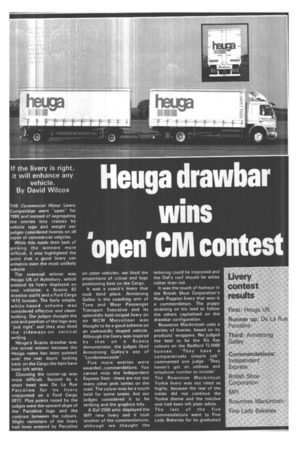Heuga drawbar wins 'open' CM contest
Page 105

Page 106

If you've noticed an error in this article please click here to report it so we can fix it.
If the livery is right, it will enhance any vehicle. By David Wilcox THE Commercial Motor Livery Competition went -open" for 1984 and instead of segregating the entries into classes by vehicle type and weight our judges considered liveries on all types of commercial vehicles.
While this made their task of picking the winners more difficult, it also highlighted the point that a good livery can enhance even the most unlikely vehicle The eventual winner was Heuga UK of Aylesbury, which entered its livery displayed on two vehicles: a Scania 82 drawbar outfit and a Ford Cargo 1615 boxvan. The fairly simple, white-based scheme was considered effective and cleanlooking. Our judges thought the size and position of the logo was ''just right" and they also liked the sideways-on vertical writing.
Heuga's Scania drawbar was the actual winner because the Heuga name has been painted over the rear doors' locking bars, on the Cargo the bars have been left white.
Choosing the runner-up was more difficult. Second by a short head was De La Rue Parceline for its livery interpreted on a Ford Cargo 0811. Plus points noted by the judges were the upward slope of the Parceline logo and the contrast between the colours. Slight variations of the livery had been entered by Parceline on other vehicles, we liked the proportions of colour and logo positioning best on the Cargo.
It was a coach's livery that took third place. Armstrong Galley is the coaching arm of Tyne and Wear Passenger Transport Executive and its splendidly bold-striped livery on an MCW Metroliner was thought to be a good scheme on an awkwardly shaped vehicle. Although the livery was inspired by that on a Scania demonstrator, the judges liked Armstrong Galley's use of "Londonewcastle".
Five more entries were awarded , commendations. You cannot miss the Independent Express fleet -there are not too many other pink lorries on the road. The colour may be a touch lurid for some tastes, but our judges considered it to be striking and the graphics tidy.
A Daf 2500 artic displayed the MFI new livery and it took another of the commendations, although we thought the lettering could be improved and the De's roof should be white rather than red.
It was the touch of humour in the British Shoe Corporation's Hush Puppies livery that won it a commendation. The puppy straining on his lead to follow the others capitalised on the drawbar configuration.
Rowntree Mackintosh uses a variety of liveries, based on its products' wrappers. We judged the best to be the Kit Kat colours on the Bedford TI_1000 boxvan. -They have a comparatively simple job" commented one judge. -They haven't got an address and telephone number to include"' The Rowntree Mackintosh Yorkie livery was not rated as highly, because the rear of the trailer did not continue the Yorkie theme and the tractive unit had been left plain white. The last of the five commendations went to Fine Lady Bakeries for its graduated
stripes and silhouette design on a Ford Cargo 0809. It missed a place in the top three because the optional Ford stripes on the Cargo's cab work against the livery on the box body; the colours match but the direction is wrong. This was also the case :con two other entries that had the Cargo stripes —they mat enhace Ford's cab but are difficulo to integrate into the total livery.
Several general points emerged from the judging. The introduction of the sideguard legisation means that sideguards should be included in the planning of the livery; they can be painted to match the body colour or the bumpers or to blend in with the chasis. A boxvan's rear elevation is always difficult because of the locking bars, handles and hinges. Generally, the judges thought the best effect was achieved if the livery was painted over these intrusions — it is worth the trouble.
Some good entries were spoilt by a common fault: the tractive unit or cab had been excluded or poorly integrated with the rest of th bodywork's livery. The cab is part of the vehicle so make it part of the livery too. And attention to detail was sometimes lacking. For example, in too many cases the tractive unit's wheels did not match the trailer wheels—they were different colour or had trims fitted.
































































































































































































































